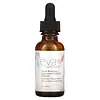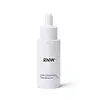What's inside
What's inside
 Key Ingredients
Key Ingredients

 Benefits
Benefits

 Concerns
Concerns

 Ingredients Side-by-side
Ingredients Side-by-side

Water
Skin ConditioningSantalum Austrocaledonicum Wood Water
Skin ConditioningAloe Barbadensis Leaf Juice
Skin ConditioningGlycerin
HumectantGlobularia Cordifolia Callus Culture Extract
Skin ConditioningRosa Canina Fruit Oil
EmollientXanthan Gum
EmulsifyingBursera Fagaroides Wood Oil
PerfumingHydrogenated Vegetable Oil
EmollientDimethyl Sulfone
SolventHydrolyzed Caesalpinia Spinosa Gum
AbsorbentCaesalpinia Spinosa Gum
Skin ConditioningPalmitoyl Tripeptide-5
Skin ConditioningPalmitoyl Tetrapeptide-7
Skin ConditioningPalmitoyl Tripeptide-1
Skin ConditioningCrithmum Maritimum Extract
Skin ConditioningUndaria Pinnatifida Cell Culture Extract
Skin ConditioningAchillea Millefolium Extract
CleansingCentella Asiatica Extract
CleansingEquisetum Arvense Extract
AstringentGanoderma Lucidum Extract
Skin ProtectingRoyal Jelly Extract
Skin ConditioningCamellia Sinensis Leaf Extract
AntimicrobialCitrus Aurantium Flower Oil
PerfumingCitrus Aurantium Leaf Oil
PerfumingCitrus Reticulata Peel Oil
MaskingSclerotium Gum
Emulsion StabilisingPotassium Sorbate
PreservativeSodium Benzoate
MaskingWater, Santalum Austrocaledonicum Wood Water, Aloe Barbadensis Leaf Juice, Glycerin, Globularia Cordifolia Callus Culture Extract, Rosa Canina Fruit Oil, Xanthan Gum, Bursera Fagaroides Wood Oil, Hydrogenated Vegetable Oil, Dimethyl Sulfone, Hydrolyzed Caesalpinia Spinosa Gum, Caesalpinia Spinosa Gum, Palmitoyl Tripeptide-5, Palmitoyl Tetrapeptide-7, Palmitoyl Tripeptide-1, Crithmum Maritimum Extract, Undaria Pinnatifida Cell Culture Extract, Achillea Millefolium Extract, Centella Asiatica Extract, Equisetum Arvense Extract, Ganoderma Lucidum Extract, Royal Jelly Extract, Camellia Sinensis Leaf Extract, Citrus Aurantium Flower Oil, Citrus Aurantium Leaf Oil, Citrus Reticulata Peel Oil, Sclerotium Gum, Potassium Sorbate, Sodium Benzoate
Water
Skin ConditioningMethylpropanediol
SolventGlycerin
HumectantNiacinamide
SmoothingAlcohol
AntimicrobialDipropylene Glycol
Humectant1,2-Hexanediol
Skin ConditioningAscorbyl Glucoside
AntioxidantGlutathione
Tranexamic Acid
AstringentNonapeptide-1
Skin ConditioningEclipta Prostrata Leaf Extract
Skin ConditioningAlgae Extract
EmollientHydrogenated Lecithin
EmulsifyingXanthan Gum
EmulsifyingCarbomer
Emulsion StabilisingAdenosine
Skin ConditioningFructooligosaccharides
HumectantBeta-Glucan
Skin ConditioningButylene Glycol
HumectantTromethamine
BufferingHydrolyzed Hyaluronic Acid
HumectantAcetyl Hexapeptide-8
HumectantCopper Tripeptide-1
Skin ConditioningPalmitoyl Tetrapeptide-7
Skin ConditioningTripeptide-1
Skin ConditioningPalmitoyl Pentapeptide-4
Skin ConditioningPalmitoyl Tripeptide-1
Skin ConditioningHexapeptide-9
Skin ConditioningEthylhexylglycerin
Skin ConditioningCaprylyl Glycol
EmollientWater, Methylpropanediol, Glycerin, Niacinamide, Alcohol, Dipropylene Glycol, 1,2-Hexanediol, Ascorbyl Glucoside, Glutathione, Tranexamic Acid, Nonapeptide-1, Eclipta Prostrata Leaf Extract, Algae Extract, Hydrogenated Lecithin, Xanthan Gum, Carbomer, Adenosine, Fructooligosaccharides, Beta-Glucan, Butylene Glycol, Tromethamine, Hydrolyzed Hyaluronic Acid, Acetyl Hexapeptide-8, Copper Tripeptide-1, Palmitoyl Tetrapeptide-7, Tripeptide-1, Palmitoyl Pentapeptide-4, Palmitoyl Tripeptide-1, Hexapeptide-9, Ethylhexylglycerin, Caprylyl Glycol
Ingredients Explained
These ingredients are found in both products.
Ingredients higher up in an ingredient list are typically present in a larger amount.
Glycerin is already naturally found in your skin. It helps moisturize and protect your skin.
A study from 2016 found glycerin to be more effective as a humectant than AHAs and hyaluronic acid.
As a humectant, it helps the skin stay hydrated by pulling moisture to your skin. The low molecular weight of glycerin allows it to pull moisture into the deeper layers of your skin.
Hydrated skin improves your skin barrier; Your skin barrier helps protect against irritants and bacteria.
Glycerin has also been found to have antimicrobial and antiviral properties. Due to these properties, glycerin is often used in wound and burn treatments.
In cosmetics, glycerin is usually derived from plants such as soybean or palm. However, it can also be sourced from animals, such as tallow or animal fat.
This ingredient is organic, colorless, odorless, and non-toxic.
Glycerin is the name for this ingredient in American English. British English uses Glycerol/Glycerine.
Learn more about GlycerinPalmitoyl Tetrapeptide-7 (formerly Palmitoyl Tetrapeptide-3) is a lab-made peptide with anti-inflammatory and skin-repairing benefits. It's made up of four amino acids (glycine, glutamine, proline, and arginine) and palmitic acid (which helps it penetrate skin more effectively).
This ingredient helps reduce inflammation by limiting the production of interleukin-6 (IL-6), a chemical that triggers inflammatory responses, particularly after UV exposure.
Less inflammation = slower collagen breakdown and a longer-lasting, youthful appearance.
Palmitoyl Tetrapeptide-7 also stimulates collagen production and supports a healthier skin barrier.
Over time, this can improve skin firmness, hydration, and reduce the appearance of fine lines. It’s commonly paired with Palmitoyl Tripeptide-1 in the well-known Matrixyl 3000 complex for enhanced anti-aging effects.
This ingredient has been shown to be effective and safe in cosmetic use and you'll typically find it in small amounts (less than 0.01%).
Due to its palmitic acid base, it may not be safe for Malassezia folliculitis.
Read more about other common types of peptides here:
Learn more about Palmitoyl Tetrapeptide-7Palmitoyl Tripeptide-1 is also known as pal-GHK. It is made up of 3 amino acids and palmitic acid, a fatty acid that helps it absorb into skin more easily.
This peptide is as a signal peptide, meaning it tells the skin to produce more collagen. Collagen is the key protein that helps form the skin's structure and keep it plump, firm, and hydrated.
By boosting collagen production, this ingredient supports a stronger skin barrier and helps reduce the appearance of wrinkles.
You'll most likely see this ingredient paired with Palmitoyl Tetrapeptide-7 in the well-known Matrixyl 3000 complex. While results from in-house testing should be viewed cautiously, this peptide duo is among the most studied and widely used in modern skincare.
Due to its palmitic acid base, this ingredient may not be safe for Malassezia folliculitis.
Read more about other common types of peptides here:
Learn more about Palmitoyl Tripeptide-1Water. It's the most common cosmetic ingredient of all. You'll usually see it at the top of ingredient lists, meaning that it makes up the largest part of the product.
So why is it so popular? Water most often acts as a solvent - this means that it helps dissolve other ingredients into the formulation.
You'll also recognize water as that liquid we all need to stay alive. If you see this, drink a glass of water. Stay hydrated!
Learn more about WaterXanthan gum is used as a stabilizer and thickener within cosmetic products. It helps give products a sticky, thick feeling - preventing them from being too runny.
On the technical side of things, xanthan gum is a polysaccharide - a combination consisting of multiple sugar molecules bonded together.
Xanthan gum is a pretty common and great ingredient. It is a natural, non-toxic, non-irritating ingredient that is also commonly used in food products.
Learn more about Xanthan Gum